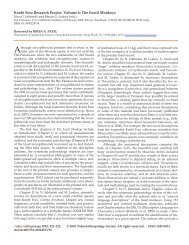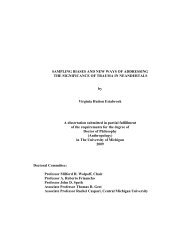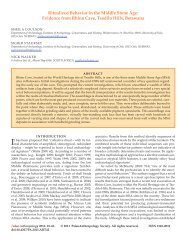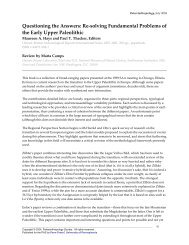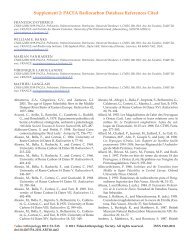PDF (12134 K) - Paleoanthropology Society
PDF (12134 K) - Paleoanthropology Society
PDF (12134 K) - Paleoanthropology Society
Create successful ePaper yourself
Turn your PDF publications into a flip-book with our unique Google optimized e-Paper software.
allows the differentiation of prehensile wear, i.e., the distinction<br />
between wear resulting from hand-held, wrapped,<br />
and hafted use (rots 2002a, 2004).<br />
dESCRIPTIon And InTERPRETATIon<br />
Based on the observed macro- and microscopic wear evidence,<br />
the lanceolate point (maximum length 148mm,<br />
maximum width 51mm, maximum thickness 16mm) is interpreted<br />
as a piece that fractured during final shaping of<br />
the distal tip while the piece was hafted. The evidence that<br />
forms the basis of this interpretation is presented in detail<br />
below (Figure 3). For clarity, the macro- and microscopic<br />
wear is dealt with separately even though both should be<br />
viewed in combination.<br />
Analysis and Interpretation of a Lanceolate Point • 237<br />
Figure 3. Drawing of the lanceolate point with references to the wear evidence.<br />
MACRoSCoPIC WEAR EvIdEnCE<br />
The medial fracture<br />
The fracture is initiated from a dorsal ridge formed by one<br />
of the largest removals on the upper face of the lanceolate<br />
point. It is the most prominent ridge on that face. The thickness<br />
of the piece at the fracture is 10mm, the width of the<br />
fracture plane is 38mm. The fracture initiation shows a<br />
clear impact point as a result of the significant pressure that<br />
caused it (Figure 4: arrow). The distinctive character of the<br />
initiation suggests that the fracture was produced as a result<br />
of contact with a hard material, following a particular<br />
sudden pressure. The fracture plane is slightly oblique, but



